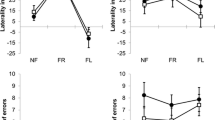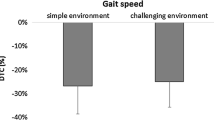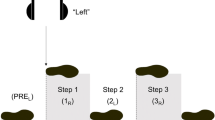Abstract
Gait stability and secondary task performance are affected by the need to share attention when dual-tasking. Further decrements may result from the need to switch attention between multiple secondary tasks. The aim of the current study was to determine the effects of attention switching upon gait stability and task performance in healthy younger and older adults. Ten healthy younger and ten healthy older adults walked on a treadmill at their preferred speed during three trials including: (1) baseline walking; (2) non-switching task walking, requiring response to an auditory-spatial or visual-spatial cue presented in an expected order; and (3) switching task walking, which required response to an auditory-spatial or visual-spatial cue presented in an unexpected order. Response time and accuracy, the margin of stability in the frontal (MoSML) and sagittal planes (MoSA: anterior, MoSP: posterior), step width and step length were calculated for non-switching and switching tasks. The MoSML, MoSA, MoSP, step width and step length during non-switching and switching tasks were normalized to baseline walking. Older adults took significantly longer to respond to cues and made more errors during the switching task compared to younger adults. Younger adults took narrower steps (p < 0.01) and displayed a reduction in MoSML (p < 0.01) during the switching task compared with the non-switching task. Conversely, older adults displayed no differences in MoSML between tasks. These findings suggest that attention switching results in different task prioritization strategies in younger and older adults during walking.




Similar content being viewed by others
Data availability
The datasets used and/or analyzed during the current study are available from the corresponding author on reasonable request.
References
Al-Yahya E, Dawes H, Smith L, Dennis A, Howells K, Cockburn J (2011) Cognitive motor interference while walking: a systematic review and meta-analysis. Neurosci Biobehav Rev 35:715–728. https://doi.org/10.1016/j.neubiorev.2010.08.008
Beurskens R, Bock O (2012) Age-related deficits of dual-task walking: A review. Neural Plast. https://doi.org/10.1155/2012/131608
Bohle H et al (2019) Behavioral and neural correlates of cognitive-motor interference during multitasking in young and old adults. Neural Plast 2019:1–19. https://doi.org/10.1155/2019/9478656
Boisgontier MP, Beets IAM, Duysens J, Nieuwboer A, Krampe RT, Swinnen SP (2013) Age-related differences in attentional cost associated with postural dual tasks: increased recruitment of generic cognitive resources in older adults. Neurosci Biobehav Rev 37:1824–1837. https://doi.org/10.1016/j.neubiorev.2013.07.014
Bruijn SM, van Dieen JH (2018) Control of human gait stability through foot placement. J R Soc Interface. https://doi.org/10.1098/rsif.2017.0816
Carvalho A, Rea IM, Parimon T, Cusack B (2014) Physical activity and cognitive function in individuals over 60 years of age: a systematic review. Clin Interv Aging. https://doi.org/10.2147/cia.s55520
Cleland CL, Hunter RF, Kee F, Cupples ME, Sallis JF, Tully MA (2014) Validity of the global physical activity questionnaire (GPAQ) in assessing levels and change in moderate-vigorous physical activity and sedentary behaviour. BMC Public Health 14:1255. https://doi.org/10.1186/1471-2458-14-1255
Cohen J (1988) Statistical power analysis for the behavioral sciences. L. Erlbaum Associates, Hillsdale
Collins SH, Kuo AD (2013) Two independent contributions to step variability during over-ground human walking. PLoS ONE. https://doi.org/10.1371/journal.pone.0073597
Deandrea S, Lucenteforte E, Bravi F, Foschi R, La Vecchia C, Negri E (2010) Risk factors for falls in community-dwelling older people: a systematic review and meta-analysis. Epidemiology 21:658–668. https://doi.org/10.1097/EDE.0b013e3181e89905
Dingwell JB, Cusumano JP, Cavanagh PR, Sternad D (2001) Local dynamic stability versus kinematic variability of continuous overground and treadmill walking. J Biomech Eng T Asme 123:27–32. https://doi.org/10.1115/1.1336798
Faul F, Erdfelder E, Lang A-G, Buchner A (2007) G*Power 3: a flexible statistical power analysis program for the social, behavioral, and biomedical sciences. Behav Res Methods 39:175–191. https://doi.org/10.3758/bf03193146
Granacher U, Bridenbaugh SA, Muehlbauer T, Wehrle A, Kressig RW (2011) Age-related effects on postural control under multi-task conditions. Gerontology 57:247–255. https://doi.org/10.1159/000322196
Green DA, Zhu JL, Shah A, Golding JF, Gresty MA (2010) Slalom walking with prism disorientation: impact on verbal and spatial tasks. Aviat Space Environ Med 81:728–734. https://doi.org/10.3357/asem.2732.2010
Gutierrez EM, Bartonek A, Haglund-Akerlind Y, Saraste H (2003) Centre of mass motion during gait in persons with myelomeningocele. Gait Posture 18:37–46. https://doi.org/10.1016/S0966-6362(02)00192-3
Hak L, Houdijk H, Steenbrink F, Mert A, van der Wurff P, Beek PJ, van Dieen JH (2012) Speeding up or slowing down?: gait adaptations to preserve gait stability in response to balance perturbations. Gait Posture 36:260–264. https://doi.org/10.1016/j.gaitpost.2012.03.005
Hawkes TD, Siu KC, Silsupadol P, Woollacott MH (2012) Why does older adults' balance become less stable when walking and performing a secondary task? Examination of attentional switching abilities. Gait Posture 35:159–163. https://doi.org/10.1016/j.gaitpost.2011.09.001
Hof AL (2008) The 'extrapolated center of mass' concept suggests a simple control of balance in walking. Hum Mov Sci 27:112–125. https://doi.org/10.1016/j.humov.2007.08.003
Hof AL, Gazendam MGJ, Sinke WE (2005) The condition for dynamic stability. J Biomech 38:1–8. https://doi.org/10.1016/j.jbiomech.2004.03.025
Hof AL, Van Bockel RM, Schoppen T, Postema K (2007) Control of lateral balance in walking. Gai Posture 25:250–258. https://doi.org/10.1016/j.gaitpost.2006.04.013
Hollman JH, Kovash FM, Kubik JJ, Linbo RA (2007) Age-related differences in spatiotemporal markers of gait stability during dual task walking. Gait Posture 26:113–119. https://doi.org/10.1016/j.gaitpost.2006.08.005
Horak FB (2006) Postural orientation and equilibrium: what do we need to know about neural control of balance to prevent falls? Age Ageing 35:7–11. https://doi.org/10.1093/ageing/afl077
Huff MJ, Balota DA, Minear M, Aschenbrenner AJ, Duchek JM (2015) Dissociative global and local task-switching costs across younger adults, middle-aged adults, older adults, and very mild Alzheimer's disease individuals. Psychol Aging 30:727–739. https://doi.org/10.1037/pag0000057
Jeon S, Kim C, Song S, Lee G (2015) Changes in gait pattern during multitask using smartphones. Work (Reading, Mass) 53:241–247. https://doi.org/10.3233/wor-152115
Jiang Y, Saxe R, Kanwisher N (2004) Functional magnetic resonance imaging provides new constraints on theories of the psychological refractory period. Psychol Sci 15:390–396. https://doi.org/10.1111/j.0956-7976.2004.00690.x
Jordan K, Challis JH, Newell KM (2007) Walking speed influences on gait cycle variability. Gait Posture 26:128–134. https://doi.org/10.1016/j.gaitpost.2006.08.010
Kim HJ, Park I, Lee HJ, Lee O (2016) The reliability and validity of gait speed with different walking pace and distances against general health, physical function, and chronic disease in aged adults. J Exerc Nutrition Biochem 20:46–50. https://doi.org/10.20463/jenb.2016.09.20.3.7
Kline JE, Poggensee K, Ferris DP (2014) Your brain on speed: cognitive performance of a spatial working memory task is not affected by walking speed. Front Hum Neurosci. https://doi.org/10.3389/fnhum.2014.00288
Koch I, Prinz W, Allport A (2005) Involuntary retrieval in alphabet-arithmetic tasks: task-mixing and task-switching costs. Psychol Res 69:252–261. https://doi.org/10.1007/s00426-004-0180-y
Kray J, Fehér B (2017) Age differences in the transfer and maintenance of practice-induced improvements in task switching: the impact of working-memory and inhibition demands. Front Psychol. https://doi.org/10.3389/fpsyg.2017.00410
Kray J, Lindenberger U (2000) Adult age differences in task switching. Psychol Aging 15:126–147. https://doi.org/10.1037//0882-7974.15.1.126
Leardini A, Benedetti MG, Berti L, Bettinelli D, Nativo R, Giannini S (2007) Rear-foot, mid-foot and fore-foot motion during the stance phase of gait. Gait Posture 25:453–462. https://doi.org/10.1016/j.gaitpost.2006.05.017
Liston MB, Bergmann JH, Keating N, Green DA, Pavlou M (2014) Postural prioritization is differentially altered in healthy older compared to younger adults during visual and auditory coded spatial multitasking. Gait Posture 39:198–204. https://doi.org/10.1016/j.gaitpost.2013.07.004
Lord SR, Ward JA, Williams P, Anstey KJ (1994) Physiological factors associated with falls in older community-dwelling women. J Am Geriatr Soc 42:1110–1117. https://doi.org/10.1111/j.1532-5415.1994.tb06218.x
Maidan I et al (2016) The role of the frontal lobe in complex walking among patients with parkinson's disease and healthy older adults: An fNIRS study. Neurorehabil Neural Repair 30:963–971. https://doi.org/10.1177/1545968316650426
Marone JR, Patel PB, Hurt CP, Grabiner MD (2014) Frontal plane margin of stability is increased during texting while walking. Gait Posture 40:243–246. https://doi.org/10.1016/j.gaitpost.2014.04.188
Menant JC, Sturnieks DL, Brodie MAD, Smith ST, Lord SR (2014) Visuospatial tasks affect locomotor control more than nonspatial tasks in older people. PLoS ONE. https://doi.org/10.1371/journal.pone.0109802
Mersmann F, Bohm S, Bierbaum S, Dietrich R, Arampatzis A (2013) Young and old adults prioritize dynamic stability control following gait perturbations when performing a concurrent cognitive task. Gait Posture 37:373–377. https://doi.org/10.1016/j.gaitpost.2012.08.005
Montero-Odasso M, Muir SW, Speechley M (2012) Dual-task complexity affects gait in people with mild cognitive impairment: the interplay between gait variability, dual tasking, and risk of falls. Arch Phys Med Rehabil 93:293–299. https://doi.org/10.1016/j.apmr.2011.08.026
Mudie KL, Gupta A, Green S, Hobara H, Clothier PJ (2017) A comparison of vertical stiffness values calculated from different measures of center of mass displacement in single-leg hopping. J Appl Biomech 33:39–47. https://doi.org/10.1123/jab.2016-0037
Muir-Hunter SW, Wittwer JE (2016) Dual-task testing to predict falls in community-dwelling older adults: a systematic review. Physiotherapy 102:29–40. https://doi.org/10.1016/j.physio.2015.04.011
Nordin E, Moe-Nilssen R, Ramnemark A, Lundin-Olsson L (2010) Changes in step-width during dual-task walking predicts falls. Gait Posture 32:92–97. https://doi.org/10.1016/j.gaitpost.2010.03.012
Pickle NT, Wilken JM, Fey NP, Silverman AK (2018) A comparison of stability metrics based on inverted pendulum models for assessment of ramp walking. PLoS ONE 13:e0206875. https://doi.org/10.1371/journal.pone.0206875
Rosenblatt NJ, Grabiner MD (2010) Measures of frontal plane stability during treadmill and overground walking. Gait Posture 31:380–384. https://doi.org/10.1016/j.gaitpost.2010.01.002
Salthouse TA (2011) What cognitive abilities are involved in trail-making performance? Intelligence 39:222–232. https://doi.org/10.1016/j.intell.2011.03.001
Sander MC, Lindenberger U, Werkle-Bergner M (2012) Lifespan age differences in working memory: a two-component framework. Neurosci Biobehav Rev 36:2007–2033. https://doi.org/10.1016/j.neubiorev.2012.06.004
Siu KC, Chou LS, Mayr U, van Donkelaar P, Woollacott MH (2008) Does inability to allocate attention contribute to balance constraints during gait in older adults? J Gerontol A Biol 63:1364–1369. https://doi.org/10.1093/gerona/63.12.1364
Siu K-C, Chou L-S, Mayr U, van Donkelaar P, Woollacott MH (2009) Attentional mechanisms contributing to balance constraints during gait: the effects of balance impairments. Brain Res 1248:59–67. https://doi.org/10.1016/j.brainres.2008.10.078
Stelzel C, Schauenburg G, Rapp MA, Heinzel S, Granacher U (2017) Age-related interference between the selection of input-output modality mappings and postural control—a pilot study. Front Psychol. https://doi.org/10.3389/fpsyg.2017.00613
Strobach T, Liepelt R, Schubert T, Kiesel A (2012) Task switching: effects of practice on switch and mixing costs. Psychol Res 76:74–83. https://doi.org/10.1007/s00426-011-0323-x
Strobach T, Wendt M, Janczyk M (2018) Editorial: Multitasking: executive functioning in dual-task and task switching situations. Front Psychol. https://doi.org/10.3389/fpsyg.2018.00108
Süptitz F, Karamanidis K, Catalá MM, Brüggemann G-P (2012) Symmetry and reproducibility of the components of dynamic stability in young adults at different walking velocities on the treadmill. J Electromyogr Kinesiol 22:301–307. https://doi.org/10.1016/j.jelekin.2011.12.007
Szameitat AJ, Lepsien J, von Cramon DY, Sterr A, Schubert T (2006) Task-order coordination in dual-task performance and the lateral prefrontal cortex: an event-related fMRI study. Psychol Res 70:541–552. https://doi.org/10.1007/s00426-005-0015-5
Thomson D, Liston M, Gupta A (2020) Does surface slope affect dual task performance and gait? An exploratory study in younger and older adults. Exp Brain Res. https://doi.org/10.1007/s00221-020-05845-4
Tomporowski PD, Audiffren M (2014) Dual-task performance in young and older adults: speed-accuracy tradeoffs in choice responding while treadmill walking. J Aging Phys Activ 22:557–563. https://doi.org/10.1123/JAPA.2012-0241
Wendt M, Klein S, Strobach T (2017) More than attentional tuning—investigating the mechanisms underlying practice gains and preparation in task switching. Front Psychol. https://doi.org/10.3389/fpsyg.2017.00682
Winter DA (1990) Biomechanics and motor control of human movement, 2nd edn. Wiley, New York
Wobbrock JO, Findlater L, Gergle D, Higgins JJ (2011) The aligned rank transform for nonparametric factorial analyses using only anova procedures. In: Paper presented at the Proceedings of the SIGCHI Conference on Human Factors in Computing Systems, Vancouver, BC, Canada,
Wollesen B, Voelcker-Rehage C (2019) Differences in cognitive-motor interference in older adults while walking and performing a visual-verbal stroop task. Front Aging Neurosci. https://doi.org/10.3389/fnagi.2018.00426
Wollesen B, Schulz S, Seydell L, Delbaere K (2017) Does dual task training improve walking performance of older adults with concern of falling? BMC Geriatr. https://doi.org/10.1186/s12877-017-0610-5
Wollesen B, Wanstrath M, Van Schooten KS, Delbaere K (2019) A taxonomy of cognitive tasks to evaluate cognitive-motor interference on spatiotemoporal gait parameters in older people: a systematic review and meta-analysis. Eur Rev Aging Phys A. https://doi.org/10.1186/s11556-019-0218-1
Woltring HJ (1986) A fortran package for generalized, cross-validatory spline smoothing and differentiation. Adv Eng Softw Workst 8:104–113. https://doi.org/10.1016/0141-1195(86)90098-7
Worden TA, Beaudette SM, Brown SHM, Vallis LA (2016) Estimating gait stability: asymmetrical loading effects measured using margin of stability and local dynamic stability. J Mot Behav 48:455–467. https://doi.org/10.1080/00222895.2015.1134433
Yogev-Seligmann G, Hausdorff JM, Giladi N (2008) The role of executive function and attention in gait. Mov Disord 23:329–342. https://doi.org/10.1002/mds.21720
Yogev-Seligmann G, Hausdorff JM, Giladi N (2012) Do we always prioritize balance when walking? Towards an integrated model of task prioritization. Mov Disord 27:765–770. https://doi.org/10.1002/mds.24963
Young PMM, Wilken JM, Dingwell JB (2012) Dynamic margins of stability during human walking in destabilizing environments. J Biomech 45:1053–1059. https://doi.org/10.1016/j.jbiomech.2011.12.027
Zeni JA, Richards JG, Higginson JS (2008) Two simple methods for determining gait events during treadmill and overground walking using kinematic data. Gait Posture 27:710–714. https://doi.org/10.1016/j.gaitpost.2007.07.007
Acknowledgements
The authors gratefully acknowledge the technical support provided by Dr Chris Wang and Brendan Howe for this study.
Funding
Funding for Mr Daniel Thomson was provided by an Australian Postgraduate Award through Western Sydney University. Dr Matthew Liston receives salary support from the National Health Medical Research Council.
Author information
Authors and Affiliations
Contributions
DT was involved in study design, collected all data, was involved in analysis and interpretation of the data and was the major contributor in writing the manuscript. AG was involved in interpretation of the data and was a contributor in writing the manuscript. ML was involved in study design, interpretation of the data and was a contributor in writing the manuscript. All authors read and approved the final manuscript.
Corresponding author
Ethics declarations
Conflict of interest
The authors have no conflicts of interest to disclose.
Ethics approval and consent to participate
Ethical approval was obtained for the current study from the institutional Human Research Ethics Committee (Reference: H11409). All participants provided written informed consent prior to participating in the study.
Consent for publication
Not applicable.
Additional information
Communicated by Francesco Lacquaniti.
Publisher's Note
Springer Nature remains neutral with regard to jurisdictional claims in published maps and institutional affiliations.
Rights and permissions
About this article
Cite this article
Thomson, D., Gupta, A. & Liston, M. Does attention switching between multiple tasks affect gait stability and task performance differently between younger and older adults?. Exp Brain Res 238, 2819–2831 (2020). https://doi.org/10.1007/s00221-020-05938-0
Received:
Accepted:
Published:
Issue Date:
DOI: https://doi.org/10.1007/s00221-020-05938-0




